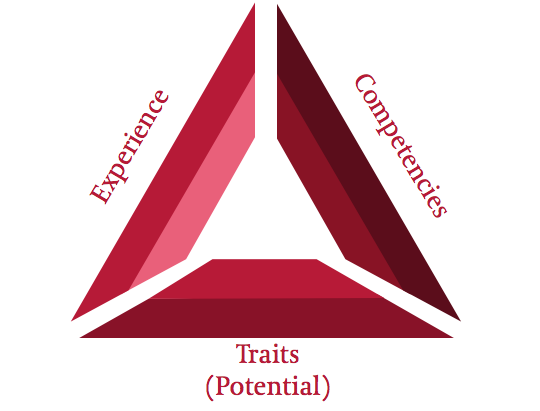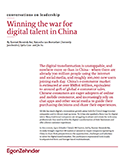The digital transformation is unstoppable, and nowhere more so than in China – where there are already 700 million people using the internet and social media, and roughly 100,000 new users joining each day. China’s e-commerce market is estimated at over RMB16 trillion, equivalent to around 40% of global e-commerce sales. Chinese consumers are eager adopters of online and mobile commerce, and increasingly rely on chat apps and other social media to guide their purchasing decisions and share their experiences.
All this has made digital a tremendous growth arena both for China’s large internet companies and its vibrant start-up scene. Yet it has also sparked a fierce war for digital talent. Many traditional companies are struggling to a ract and retain the tech-savvy professionals they need to drive the digital transformation of their businesses and offer a better customer experience.
In this context, Egon Zehnder China’s HR Practice, led by Xuemei Bennink-Bai, recently brought together HR leaders of around 20 major companies operating in China to share their perspectives on the opportunities, challenges and solutions in talent for digital transformation. The participants represented both locally headquartered rms and foreign-based multinationals.
The discussions, held in Beijing and Shanghai, led to three main insights:
1. Hiring talent directly from pure-play internet companies generally does not work. Instead, traditional companies should identify and source high-potential talent from a broader set of backgrounds – and combine them with those with the right traits from within their own organizations.
2. Perhaps the most important factor in nurturing and retaining digital talent is organizational culture. Companies and their leaders should consciously build cultures that encourage experimentation and learning, speed and adaptability.
3. While digital has profound implications for how companies serve and engage with their customers, internal transformation is just as key. Pioneering firms are harnessing digital to make processes such as HR and R&D much faster and more personal – so making it easier for millennials to thrive.
Where to hire? Avoid pure-play internet, and think potential
China’s big internet players are enjoying rapid growth, and have the cash and will to spend heavily on compensation. Competing directly with them for talent is often a recipe for disappointment, as participants at our events atested. Several HR leaders of traditional companies had hired talent from pure-play internet companies, only to see those recruits head back to tech-centric firms within months: one company reported 40% annual turnover in its digital team. China’s dynamic digital startup ecosystem – which is supported both by the big internet firms and the government – is a further source of fierce competition for talent.
In this challenging context, mainstream companies driving a digital transformation should be very specific about which digital roles are most important for them – and then think broadly about how and where to source the talent for to fill those roles.
Natascha Jacobovits-van Boetzelaer, global leader of Egon Zehnder’s Digital practice, emphasized that it is essential to define what digital means for the organization – which in turn will influence the specific roles to recruit for, and the requirements for each role. For example, an e-commerce leader or digital marketing role has a different profile from a Chief Digital Officer. Companies then need to understand what success looks like in each role – and define the metrics to measure that success, such as site traffic numbers, customer conversion rates, and click-to-buy impact.
She also argued that, in order to assess digital talent effectively, companies need to learn new terminology and adjust the relative importance of the three assessment “lenses” – experience, competencies, and potential (Exhibit 1). Whereas traditional assessments emphasise the candidate’s experience, companies assessing digital talent should put much more weight on the “potential” lens – because they are looking for people to succeed in an area that is still largely unchartered. Specifically, companies should look for candidates who stand out in the traits of curiosity and insight.
In terms of competencies, companies should focus on those that are most relevant to operating in a digital role. The key competencies to look for are customer orientation – as customer centricity is key to success in digital transformation – as well as strategic orientation. Collaboration and influencing are also critical: in traditional companies, digital talent must constantly explain and motivate the digital transformation to colleagues.
Exhibit 1:
Assessing digital talent
In order to assess digital talent, we need to learn new terminology and adjust the relative importance of our three assessment lenses

One of the participants at our events, the China HR leader of a Europe-based multinational, related how they had used potential-based assessments to identify the right internal candidate for the role of “Chief Disruptive Officer”. The successful candidate, even though she did not have deep digital expertise, had strong business experience matched with keen learning ability and ease with engaging people in an informal, collaborative way.
Companies also need to reshape their longer-term talent pipeline – to ensure that they have the right Competencies Traits (Potential) Experience 4 conversations on leadership breadth of skillsets and traits inside their organizations to sustain digital growth and innovation in the future. That means, in recruiting entry-level staff, companies need to expand their hiring criteria to embrace greater diversity of background and perspective – and not simply focus on fresh graduates from the schools and disciplines from which they have traditionally recruited.
Build a culture that nurtures digital talent and innovation
Once you’ve identified the right talent to drive your digital transformation, how do you make sure they’re motivated to innovate, perform, and stay with your company for the medium to long term?
Some of the companies represented at our events had experimented with compensation structures designed to reward digital talent for short-term successes such as the launch and scale-up of new platforms. But there was broad agreement that it is almost impossible to compete with pure-play internet players on compensation alone. Rather, the key to retaining and inspiring new-generation talent is non-financial. In the words of one participant, “it’s all about the culture”.
In a traditional offline business, shaping a culture relevant to the digital age is no small ask. It requires a high degree of customer focus, experimentation, collaboration, constant learning, and willingness to “fail fast”. One of the participants, the China HR leader of a global financial services firm, spoke of how they were cultivating this “experimental spirit” in their business – and moving away from the assumption that “we know everything”. They were encouraging digital talent to question and debate the company’s business model and core products – asking, for example, whether credit cards would exist in the future. The company was also forming close partnerships with pure-play technology players, and enabling its own digital talent to co-create with those partners.
For senior leadership, achieving and sustaining this kind of culture shift demands a willingness to learn and a real commitment to act on that learning: “Behavioral change needs to start from the executives,” as one participant said. Another participant concurred: “Top leadership must make a commitment to digital, and then visibly adopt a digital mind-set to influence other people in the organization.” Digital talent also has a key role to play in building this new culture. Given the space to try innovative ideas, make mistakes, and learn from customers and colleagues, they will serve as role models for the rest of the organization.
Several participants at our events reported that efforts to shift organizational culture were already paying off in terms of talent retention and motivation. For example, the China HR leader of a Europebased automotive firm said that several digital stars who had left to join pure-play tech companies had returned to the auto player, because of the strong emotional connection between employees and the brand values. In her words:
“As a traditional company, it’s hard for us to compete with internet or start-up companies in many respects. So my suggestion is to ‘stay true to who you are’ in your culture and branding. Talented people who identify with your company’s values will stay with you.”
Several other participants made the point that, for new-generation talent, working in a digital role in a large, traditional organization is a chance to make an impact on a larger scale. In their communication to digital talent, companies should emphasize the culture and values of their organizations – and the opportunity to “change the world”. In the words of one participant: “Digital talent wants to do something that is concrete and socially meaningful. That can actually make it easier for traditional industries to hire them.”
Harness digital to transform internal processes – including HR
Digital talent thrives in an environment of speed, flexibility, openness and creativity – and nothing is more likely to sap their motivation than the feeling of being trapped in an old-style corporate bureaucracy. That means the digital transformation must be lived and experienced every day through the company’s internal processes – which again entails a fundamental shift for many organizations.
Participants at our events shared some exciting examples of how they are harnessing digital tools and mind-sets to reshape talent, HR and R&D systems. As one HR executive reported:
“At our company, we encourage digital innovation. For example, we recently recognized a researcher in our HR department as an ‘innovation champion’ after he developed a tool to analyze resumes based on keywords, to improve the quality and efficiency of candidate shortlisting. Now we are thinking about how to digitize other key HR activities and processes, such as our assessment of leadership potential.”
Another company, drawing on best practice by global tech leaders, has adopted an innovative way to distribute HR tasks: they put every task up for online “auction”. HR colleagues bid for tasks such as recruitment, for which project teams across the business offer a “price” they can pay – leading to a premium on more complex tasks. As the HR leader of this company reported: “By adopting this auction mechanism, HR colleagues choose the tasks that motivate them – they no longer just take tasks from their team leaders. As a result, we’ve seen a real improvement in ownership, accountability and productivity.”
Similar innovations are underway in other internal processes. For example, an automotive company has seen its R&D team partner with a leading social media company to imagine the future of automated cars in China. At the same time, its marketing department is working closely with chat apps to promote the company’s brand.
Digital is disrupting markets and business models, and unleashing an unprecedented war for talent. As China’s HR leaders readily acknowledge, navigating the digital transformation of a traditional 6 conversations on leadership company can be a struggle. Yet many of these practitioners are driving tremendous innovation as they imagine new approaches and muster the courage to experiment, fail, learn and change. They are shaping the future – for their companies, their customers, and their colleagues.
Egon Zehnder’s role is to help our clients articulate their purpose and vision for digital transformation, guide them to the best talent (internal and external), and help them develop an innovation culture in their organization.






